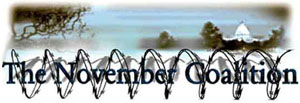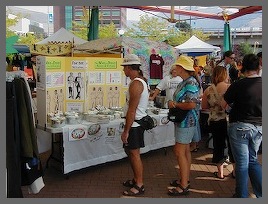
Missoula HempFest: Missoula, MT 2006
A public event can be large or small, but no one expects a volunteer to expend large amounts of time for a small event. Likewise, without at least a well planned effort, a public event will probably be small.
A small event is great if the small group has come together for a meaningful purpose. Likewise, after a large public event closes and the audience 'scatters to the winds,' if the organizer is left with the same core group at the end of an exhausting, expensive venture, you'll want to re-think the purpose and goals of your meetings and events.
Events usually fall into the following four categories, not all requiring experience and exceptional skill to carry out:
Speaker's Forum or Panel Presentation
Planning Meeting
Discussion Group
Demonstration or March
Media Appearance
Educational "Tabling"
Fundraiser
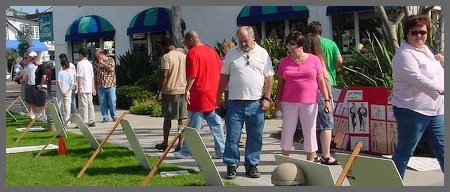
OCNORML and November Coalition Rally Against the Drug War: Laguna Beach, CA 2006
Organizing events through planning meetings will help you and your group learn or increase skills in preparation, working together and follow up. Large events usually start with small meetings. Getting started is key.
An experienced organizer might consider a series of events. When you're ready to announce a major event, subsidiary or supplemental events can be planned. An example of a subsidiary event is a media appearance prior to the event, or after. Sometimes a local radio host will request an interview; if you're feeling confident, make an appointment with the newspaper editorial board or its selected representative in conjunction with certain public events.
Search a school's website for a student organization(s) that seems likely to cosponsor a public meeting with you. Find a faculty member with interest in the issue. Criminal justice and chemical dependency professors are obvious people to contact, but in these times over-use of imprisonment, prison abuse and the drug war disaster have created new choices for individuals who study or work in public health, social, economic and civil freedom disciplines.
But first, your group must agree on the purpose for the proposed public event, its agenda, the meeting place, date and time.
You will need four to eight weeks, and about four group meetings to plan one. Meet with local organizers early, midway, and then again before the event to keep in close touch. Be prepared to address their concerns, and don't assume anything. Ask questions.
Facilitate growth in your group by keeping everyone focused on building maximum results from careful attention to details. Remember to thank people involved, and answer their questions, too. Most of us are nervous doing something new, especially something public. Being well prepared definitely helps.
Purpose and Timely Agenda
It doesn't matter what kind of public event you choose, or if you didn’t choose a purpose and plan an agenda.
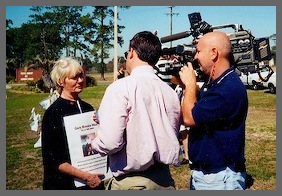
2 Million Too Many: Kay Lee in Starke, FL 2000
When the public meets, set up a table, a display if possible, and decide how you'll collect contact information from people that attend. An informational table should be located where leaders can meet with the public before and after the event.
Another purpose of every meeting should be people meeting like-minded people. Small meeting or large, be sure you enlist one or more people to assist in introductions.
Our message of drug war injustice fits into the broader issue of human rights, social justice, and peace movements. Over-reliance on imprisonment and the criminalization of millions of people through drug law violations, falls within broad concerns. Prison reform groups trying to solve problems that formerly incarcerated people endure usually voice concerns about the drug war’s effect on people in jails and prisons.
A leader's job is to help people find common ground. Never forget this in the purpose for bringing everyone together.
Who, What, Why, When and Where?
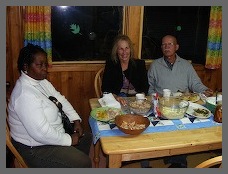
Board Meeting & Autumn Benefit: Colville, WA 2007
The 'What' question is already answered in part. You are holding one or more series of events. If any local experts or notables were to be present, they would be the 'Who', along with others in your group. Sometimes two organizations plan together in collaboration, so the ‘Who’ are a list of more than one group.
Why are you having the public event? What would your answer be in 30 seconds? Or in one, written paragraph? What are your community education goals? Why would you want to hold a community discussion, or show a film and invite the public? The answers to these questions are the "why you are planning and hosting a public gathering."
Perhaps some feature of the war on drugs has recently aroused public interest, maybe a botched drug raid, or similarities between the inhumane treatment of Iraqi prisoners and how it mirrors treatment of people imprisoned in the U.S., or the expensive mandatory sentencing laws. Perhaps your community has expressed concern about the use of drug task forces, and whole neighborhoods have had people arrested on the words of “cooperating informants.”
Don't hesitate to use recent local events as good reasons to call for public events.
What do you want people to learn by attending or participating? Will you present a course of action?
Where can you hold a public meeting? You’d be surprised at the availability of meeting space, and we've dedicated an entire section of the [Organizers’s Appendix] to the subject. Informational tables are a common feature of most public events -- so is special equipment, microphones, video machines.
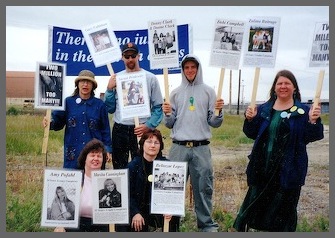
Mother's Day Protest: Chico, CA 2001
A volunteer should be assigned to answer questions, and to greet people who visit the tabling area. Always remember to collect names, addresses, emails and phone numbers from anyone willing to share this information with local organizers. If one person gently reminds people to sign in at the information table, better yet. To grow local groups, you will need local contact information from interested volunteers. They'll tell you to contact them for future meetings, actions and events.
If a reporter is covering the event, you can count them as early arrivals. Be set-up, and have the appointed public spokespersons present beforehand.
A designated 'spokesperson' will introduce speakers, and any local guest speakers.
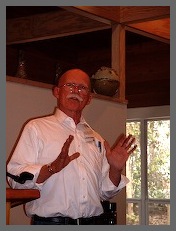
TNC Advisor John Chase
If a local spokesperson is not sharing public speaking time, and you have pertinent local information, websites, upcoming meetings, etc., write that information down. One of the public speakers should share this information with the audience.
When the meeting is over, people will visit the tables again. Remember to have volunteers at the tables when the formal presentation part of the evening is over. Just as planning meetings should be timely, not running out of time during a public meeting's important, too. Make sure that all guest or member speakers know the agenda, have their speaking times and know exactly how long their portion is. One of the leader/organizers should remind the speakers of their obligation to stay within the allotted time.
Plan on time for audience participation, and for people to mingle and meet when the formal portion of the meeting concludes. If you go 'overtime,' the public will quickly scatter. You don't want this result, right?
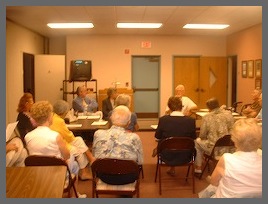
Journey for Justice: Phoenix, AZ 2003
